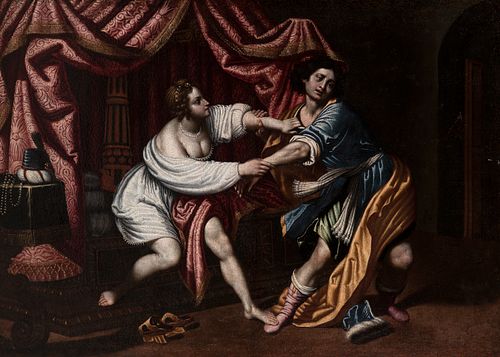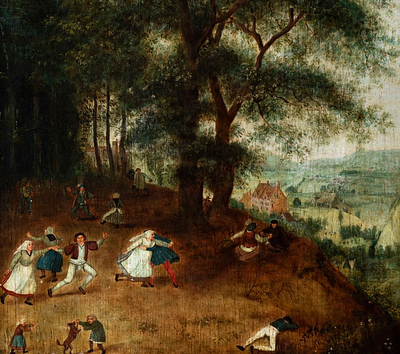School of GIOVANNI BILIVERTI (Florence, 1585-Florence, 1644); Italy, 17th century. "Joseph and Potiphar's wife", Oil on canvas. Relined.
Lot 52
About Seller
Setdart Auction House
Carrer Aragó 346
Barcelona
Spain
Setdart Subastas was born in 2004 and is currently the first online art auction in Spain with solidity, prestige and reliability guaranteed by our more than 60,000 users. Setdart has a young, dynamic and enterprising team ready to successfully manage the purchase and sale of art works through custom...Read more
Estimate:
EUR€14,000 - EUR€16,000
$15,053.76 - $17,204.30
Absentee vs Live bid
Two ways to bid:
- Leave a max absentee bid and the platform will bid on your behalf up to your maximum bid during the live auction.
- Bid live during the auction and your bids will be submitted real-time to the auctioneer.
Bid Increments
| Price | Bid Increment |
|---|---|
| EUR€0 | EUR€10 |
| EUR€200 | EUR€25 |
| EUR€500 | EUR€50 |
| EUR€1,000 | EUR€100 |
| EUR€3,000 | EUR€200 |
| EUR€5,000 | EUR€500 |
| EUR€10,000 | EUR€1,000 |
| EUR€20,000 | EUR€2,000 |
| EUR€50,000 | EUR€5,000 |
About Auction
By Setdart Auction House
Jun 30, 2021
Set Reminder
2021-06-30 08:30:00
2021-06-30 08:30:00
America/New_York
Bidsquare
Bidsquare : Old Masters
https://www.bidsquare.com/auctions/setdart-auction-house/old-masters-7134
Setdart Auction House sofia@setdart.com
Setdart Auction House sofia@setdart.com
- Lot Description
School of GIOVANNI BILIVERTI (Florence, 1585-Florence, 1644); Italy, 17th century. "Joseph and Potiphar's wife", Oil on canvas. Relined. Presents restorations and repaints. Antique Frame. Measures: 120 x 171 cm; 135 x 182 cm (frame). Based on the scriptures of Genesis, this work visually narrates the attempt of Potiphar's wife to seduce Joseph. Potiphar, who was a high ranking member of Pharaoh's court, had acquired Joseph, who had been sold into slavery. After his diligence, Potiphar, appointed Joseph head of the house, it was at that time, when Potiphar's wife began to notice Joseph, trying to seduce him. Taking advantage of an occasion when the house did not have any of the men in charge, the woman insinuated herself to Joseph, who fled. However, upon Potiphar's return, the woman accused Joseph of attempted rape, for which Joseph was sent to prison. This scene shows the moment in which Joseph tries to flee, while the woman grabs him, trying to restrain him. Placed in a rich interior, reminiscent of scenes of the Venetian school, the two characters are arranged in the center of the composition, inscribed in a bulky curtain that reveals a background, with a column, largely reminiscent of the papiriformes, typical of Egyptian culture. A detail that could allude to the philological origin of the story. Regarding the rest of the elements that make up the scene, the cap, which could be Putifar's, the slippers, and the pearls indicate the high social status of the protagonist. However, the most remarkable feature of the work lies in the expressiveness achieved through the gesture of the faces, the volume of the bodies, the angularity of the folds of the clothes, and to a greater extent the posture. Which concentrates the movement of the scene, in a composition that oscillates between the classic triangle and the cross, developed in full baroque. The woman not only grabs Joseph's arm, but also brings one leg forward, to step on Joseph's foot and trap him even more. Joseph, who tries to flee, shifts his hip, bending one of his legs strongly, which allows us to see a detailed musculature of Michelangelesque heritage. It is worth noting that the composition of this work has a great similarity with some of the same theme, made in the circle of Giovanni Biliverti, especially with the work of the same subject of the author (Biliverti), preserved today in the Pitti Palace in Florence. Both paintings present the same composition and distribution of space, also the anecdotal elements such as pearls, or the cap are found in both paintings, thus showing that this piece follows the guidelines imposed by the master Biliverti. Italian painter who began his training in the workshop of Alessandro Casolani in Siena. Later, in 1603, he began to work with Ludovico Cigoli, with whom he worked on several projects, some of them linked to Pope Clement VIII, and in 1609 he continued his training at the Academy of Design in Florence, working during this period for Cosimo II de Medici. Throughout his life, he worked in both sculpture and painting, until he became blind.
- Shipping Info
-
In-house shipping available. Please inquire at admin@setdart.com.
-
- Buyer's Premium



 EUR
EUR CAD
CAD AUD
AUD GBP
GBP MXN
MXN HKD
HKD CNY
CNY MYR
MYR SEK
SEK SGD
SGD CHF
CHF THB
THB

















